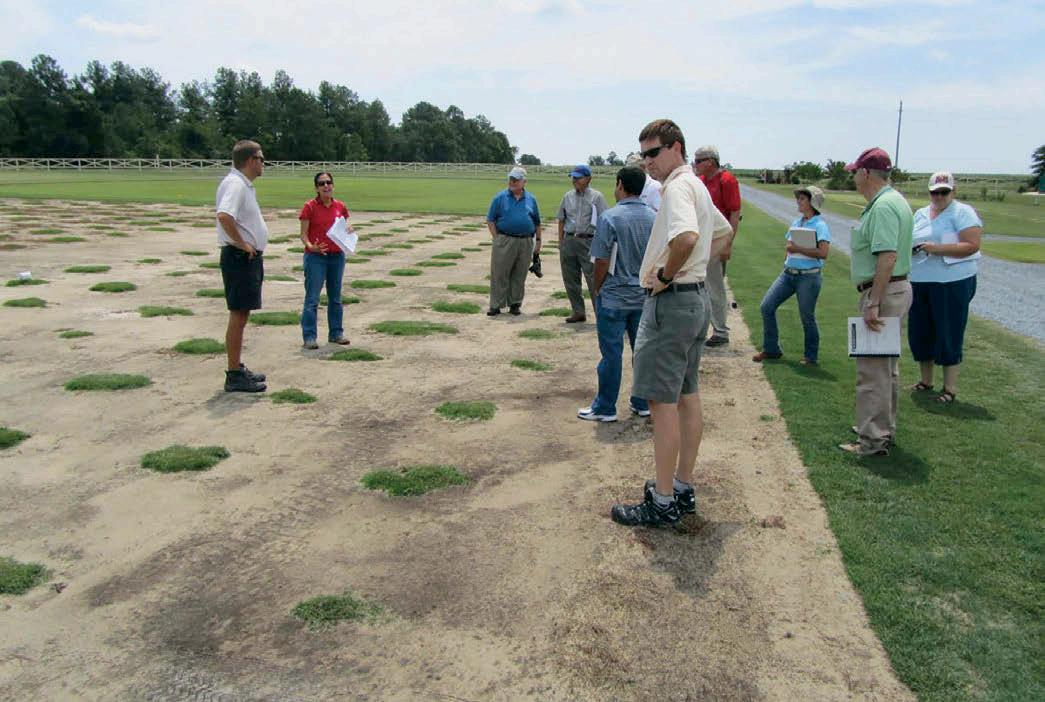UNIVERSITY SCIENTISTS GROW WATER SAVINGS WITH DROUGHT-TOLERANT TURFGRASS By Jennifer Howard Editor’s note: When this article was written, on April 27, 2020, Covid-19 restrictions had dramatically impacted research activities. See the Sidebar for an update on how 2020 played out and what is predicted for research activities in 2021. Which half of landscape water use is wasted? Experts estimate that more than 50 percent of our outdoor irrigation goes to waste—even more in dry years and dry climates. Our landscape watering habits are the primary culprit in this overflow. It’s a big issue. The typical suburban homeowner irrigates an estimated 10,000 gallons of water each year, primarily aimed at their lawn. Conserving our freshwater supply is essential for long term sustainability.
group’s work producing drought-tolerant warm-season turfgrasses. The team (representing five universities— North Carolina State University, Texas A&M University, University of Florida, University of Georgia, and Oklahoma State University) has collaborated for ten years with a rotating leadership structure. For the five-year grant that began in 2020, the team decided to expand the evaluations out west and invited the University of California Riverside, lead by Dr. Jim Baird, to join in the collaboration. Thus, the team is now 32 scientists strong. NC State’s Dr. Susana Milla-Lewis, associate professor of Turfgrass Breeding and Genetics, is at the helm in their new phase of study. “Our 2010 and 2015 projects were crucial in the development of drought-tolerant turfgrass cultivars. The levels of improvement of these grasses are promising and validate the need to promote adoption, continue cultivar research, and develop tools that facilitate the breeding process,” Milla-Lewis said.
Early Season Success The team of turfgrass researchers’ work has focused on selecting and testing drought-tolerant cultivars of four of the most economically important warm-season turfgrass species in the southern U.S. By exchanging plant materials and data among university breeders, turf varieties are tested under many climatic conditions, and the results accumulate quickly. Milla-Lewis’s team reviews test plots in 2019.
Saving Water & Natural Grass’ Benefits Turfgrasses occupy over 30 million acres in the U.S. It’s tempting to assume that eliminating our outdoor grass carpeting could solve the water demand problem. But it’s not so simple. Natural grass provides substantial environmental and economic benefits in our landscape. It mitigates heat around our homes, stabilizes soil against erosion, provides safe play space, and reduces noise, glare, and pollution. Eliminating natural grass would create a whole new set of environmental challenges.
“The collaboration among breeders across such different environments is priceless,” Milla-Lewis said. “It helps us select better lines with more performance stability because they have been tested against a wide range of weather conditions like drought and cold as well as an array of pests and diseases.”
A network of turfgrass researchers from six major universities, including NC State, is solving this dilemma by developing turfgrasses that are attractive and healthy with minimal water.
NC State Leads New Research The National Institute of Food and Agriculture approved a specialty crops grant to continue the multi-university 28
MS Student Greta Rockstad makes turfgrass crosses in the greenhouse.
TPI Turf News May/June 2021






